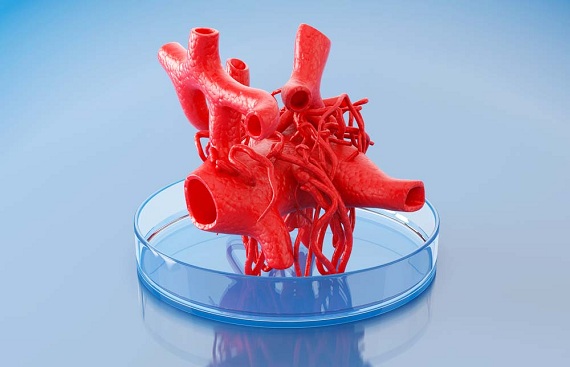Bioprinting and 3D Organ Fabrication the Forefront of Medical Advancements

The biotechnology industry has seen a significant transformation in recent years, which is set to revolutionize healthcare and expand the boundaries of medical research to unprecedented levels. Bioprinting, a new technique that effortlessly integrates the principles of 3D printing with the complexities of biology, is at the center of this extraordinary advancement. Bioprinting has become a symbol of hope for medical advances due to its capacity to create complex living tissues and, surprisingly, complete organs. This article provides an overview of the paradigm-shifting field of bioprinting and its significant implications for creating 3D organs. By diving into its core principles, we reveal a fascinating voyage into the world of scientific discovery and the opportunities that lie ahead.
What is Bioprinting?
In bioprinting, living cells, biomaterials, and growth hormones are arranged precisely to create three-dimensional constructions that resemble genuine tissues or organs. Fundamentally, bioprinting uses methods similar to conventional 3D printing, in which successive layers of material are placed to create a finished object. However, in the case of bioprinting, the ‘ink’ consists of living cells enclosed in a substance called ‘bioink,’ which resembles a hydrogel. By making it possible to develop usable tissues and organs for transplantation, this cutting-edge technology has the potential to transform the area of regenerative medicine completely.
Extrusion-based Bioprinting
![]()
One of the most popular methods for bioprinting is extrusion-based. It orchestrates the precise layer-by-layer building of 3D structures by directing bioink through a specialized nozzle. The precision of this technology makes it easier to create complex designs that resemble native tissue architectures. Extrusion-based bioprinting has been skilfully used to create blood arteries, skin, and cartilage. This development shows potential for personalized healthcare options, organ transplantation, and regenerative medicine.
Bioinks: Types and Formulations
![]()
The success of bioprinting depends heavily on bio-inks. Specific qualities are required for these inks, including biocompatibility, acceptable mechanical characteristics, and the ability to support cell viability and proliferation. Many different bioink compositions are now available, ranging from synthetic materials to organic polymers like collagen and alginate. Researchers continuously improve these formulations to improve cellular responses and tissue development within bio-printed constructions. Some of the types are mentioned below.
Hydrogel-Based Bioinks: Hydrogels are water-swollen polymer networks that closely mimic tissues' extracellular matrix (ECM). They provide a supportive environment for cell growth and tissue formation. Common hydrogel-based bio-inks are Alginate-based bio-inks, Gelatin-based bio-inks, and Fibrin-based bio-inks
Synthetic Polymer-Based Bioinks: Synthetic polymers offer tunable mechanical properties and degradation rates. Some examples include:
- Polyethylene glycol hydrogels
- Polylactic acid and Polyglycolic acid
- Polycaprolactone
Cell-Laden Bioinks: contain both cells and a supporting matrix material. They enable the simultaneous deposition of cells and biomaterials, allowing for the fabrication of complex tissues. Cell-laden bio-inks often use hydrogels as the supporting matrix.
Biocompatibility and Immunogenicity
The primary goal of bioprinting is to ensure biocompatibility, which is the capacity of a substance to coexist with living tissue without damaging it. Furthermore, for optimal tissue integration, it is crucial to reduce immunogenicity, which is the possibility that the immune system would reject bioprinted structures. To lessen immunological reactions and improve the recipient's body's acceptance of the bio-printed tissues, researchers are committed to fine-tuning bioink compositions and printing conditions.
Tissue Engineering and Regenerative Medicine
![]()
Through the use of bioprinting technologies, tissue engineering, and regenerative medicine stand to benefit greatly. Organ shortages could be solved, and individualized medical treatments could be provided with the help of bio-printed tissues and organs. This advancement also makes illness modeling easier for research and drug testing, hastening the creation of efficient cures. The synergy between bioprinting and these sectors predicts a future in which medical care is improved, and human health reaches new heights.
Safety and Long-term Effects
The potential for bioprinting to revolutionize medical treatments is undeniable, but it is crucial to stress the importance of long-term consequences and safety in this developing industry. A strict commitment to extensive testing must balance the appeal of developing personalized, functional tissues. To determine the bio-printed tissues' resilience over lengthy periods, the stability and durability of the tissues must be carefully examined. Vascularization is one of the essential frontiers, where the challenging process of creating complex blood artery networks inside printed constructions plays a crucial role. The successful integration and longevity of such structures post-transplantation depend on the researchers' skill in tackling this task; hence this complex process must receive careful attention. The persistent commitment to safety must be kept in mind as we navigate the fascinating possibilities of bioprinting.
Successful Organ Fabrication
The bioprinting of functioning organs has advanced remarkably. A huge step towards the ultimate creation of whole, transplantable organs has been made by scientists' successful bioprinting of tissues such as the liver, heart, kidney, and lung. These developments portend a potential revolution in organ transplantation and a moment when patients needing life-saving organs could get the prompt and individualized care they require.
As a result, bioprinting is shown as a crucial intersection where technology and healthcare collide. The successful collaboration of academics, medical professionals, moral philosophers, and decision-makers is essential to its progress. They have limitless potential together to explore this cutting-edge world's potential. Obstacles notwithstanding, the alluring possibility of real, 3D-printed organs beckons, with the potential to transform organ transplantation and change the nature of modern medical procedures. Despite the complexity of the road ahead, bio printing’s trajectory signals a revolutionary period in advancing human well-being.
